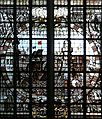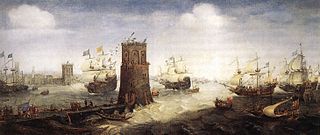
Year 1218 (MCCXVIII) was a common year starting on Monday of the Julian calendar.

Haarlem is a city and municipality in the Netherlands. It is the capital of the province of North Holland. Haarlem is situated at the northern edge of the Randstad, one of the more populated metropolitan areas in Europe; it is also part of the Amsterdam metropolitan area. Haarlem had a population of 162,543 in 2021.
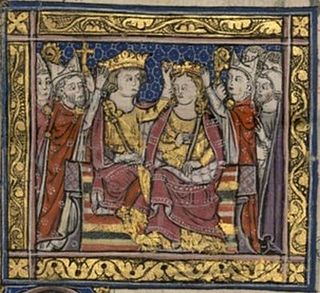
John of Brienne, also known as John I, was King of Jerusalem from 1210 to 1225 and Latin Emperor of Constantinople from 1229 to 1237. He was the youngest son of Erard II of Brienne, a wealthy nobleman in Champagne. John, originally destined for an ecclesiastical career, became a knight and owned small estates in Champagne around 1200. After the death of his brother, Walter III, he ruled the County of Brienne on behalf of his minor nephew Walter IV.

The Fifth Crusade was a campaign in a series of Crusades by Western Europeans to reacquire Jerusalem and the rest of the Holy Land by first conquering Egypt, ruled by the powerful Ayyubid sultanate, led by al-Adil, brother of Saladin.
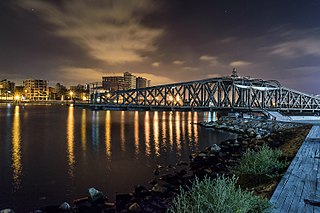
Damietta is a port city and the capital of the Damietta Governorate in Egypt. It is located at the Damietta branch, an eastern distributary of the Nile Delta, 15 kilometres (9.3 mi) from the Mediterranean Sea, and about 200 kilometres (120 mi) north of Cairo. It was a Catholic bishopric and is a multiple titular see. It is also a member of the UNESCO Global Network of Learning Cities.

The Grote Kerk or St.-Bavokerk is a Reformed Protestant church and former Catholic cathedral located on the central market square in the Dutch city of Haarlem. Another Haarlem church called the Cathedral of Saint Bavo now serves as the main cathedral for the Roman Catholic Diocese of Haarlem-Amsterdam.
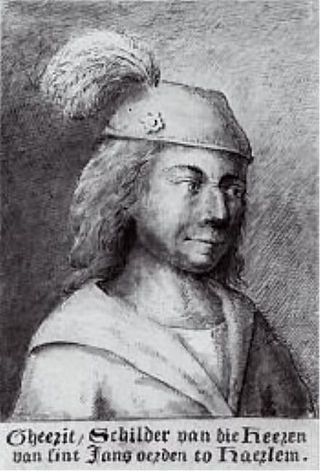
Geertgen tot Sint Jans, also known as Geertgen van Haarlem, Gerrit van Haarlem, Gerrit Gerritsz, Gheertgen, Geerrit, Gheerrit, or any other diminutive form of Gerald, was an Early Netherlandish painter from the northern Low Countries in the Holy Roman Empire. No contemporary documentation of his life has been traced, and the earliest published account of his life and work is from 1604, in Karel van Mander's Schilder-boeck.

The siege of Damietta of 1218–1219 was part of the Fifth Crusade in which the Crusaders attacked the Egyptian port city of Damietta. The city, under the control of the Ayyubid sultan al-Kamil, was besieged in 1218 and taken by the Crusaders in 1219.

Hendrik Cornelisz Vroom was a Dutch Golden Age painter credited with being the founder of Dutch marine art or seascape painting. Beginning with the "birds-eye" viewpoint of earlier Netherlandish marine art, his later works show a view from lower down, and more realistic depiction of the seas themselves. He is not to be confused with his son and pupil Cornelis Vroom.

The Grote Markt is the central market square of Haarlem, Netherlands.

Frisian involvement in the Crusades is attested from the very beginning of the First Crusade, but their presence is only felt substantially during the Fifth Crusade. They participated in almost all the major Crusades and the Reconquista. The Frisians are almost always referred to collectively by contemporary chroniclers of the Crusades and few names of individual Frisian crusaders can be found in the historical record. They generally composed a naval force in conjunction with other larger bodies of crusaders.

Egypt was repeatedly invaded from 1163 to 1169 by King Amalric of Jerusalem, who wished to strengthen its position in the Levant by taking advantage of the weakness of the Fatimid Caliphate.

Cornelis Claesz van Wieringen was a Dutch Golden Age painter.

The Stadsbibliotheek Haarlem is a collective name for all public libraries in the Haarlem area of the Netherlands. The first public library of Haarlem opened in 1921 at the cloisters of the Haarlem City Hall where the academic library had been since 1821. The move to open its doors to the public with a public reading room was only possible after the previous occupant of the downstairs cloisters, the Frans Hals Museum, moved out in 1913 to its present location. As of 2009, there are 6 public libraries and 10 lending points, such as in hospitals.
Willem van Brederode was an admiral-captain and an important partisan of the Hook faction during the Hook and Cod wars.

The coat of arms of Haarlem is the official symbol of the city of Haarlem. The sword and stars can be found as public decorations throughout the city.
Oliver of Paderborn, also known as Oliver Scholasticus or Oliver of Cologne, was a German cleric, crusader and chronicler. He was the bishop of Paderborn from 1223 until 1225, when Pope Honorius III made him cardinal-bishop of Sabina. He was the first Paderborn bishop to become a cardinal. Oliver played a significant role in the Crusades as a preacher, participant and chronicler.
De itinere Frisonum is an eyewitness account written in Latin of the Frisian crusaders' journey from Friesland to Acre during the Fifth Crusade (1217–1218). The narrative was composed by an anonymous participant of the venture who most likely was a member of the clergy. Abbot Emo of Friesland of the Premonstratensian monastery of Bloemhof copied it without alterations into his chronicle. Emo's version is the only surviving copy of the lost original and it is kept in the Library of the University of Groningen in the Netherlands. The narrative is noteworthy for its detailed description of the geography of the lands encountered by the Frisian Crusaders on their journey and the author's perspective on the motivations of his compatriots during the venture. The narrative runs parallel up to the Frisian fleet's arrival to Lisbon with the Rhenish text known as Gesta crucigerorum Rhenanorum.
The battle of Mansurah took place from 26–28 August 1221 near the Egyptian city of Mansurah and was the final battle in the Fifth Crusade (1217–1221). It pitted the Crusader forces under papal legate Pelagius Galvani and John of Brienne, king of Jerusalem, against the Ayyubid forces of the sultan al-Kamil. The result was a decisive victory for the Egyptians and forced the surrender of the Crusaders and their departure from Egypt.
The battle of Fāriskūr was a pitched battle fought between the army of the Fifth Crusade and Ayyubid Egypt on 29 August 1219 outside the Ayyubid encampment at Fāriskūr. It was fought while the siege of Damietta was ongoing. An Ayyubid victory, it had little effect on the course of the war.


